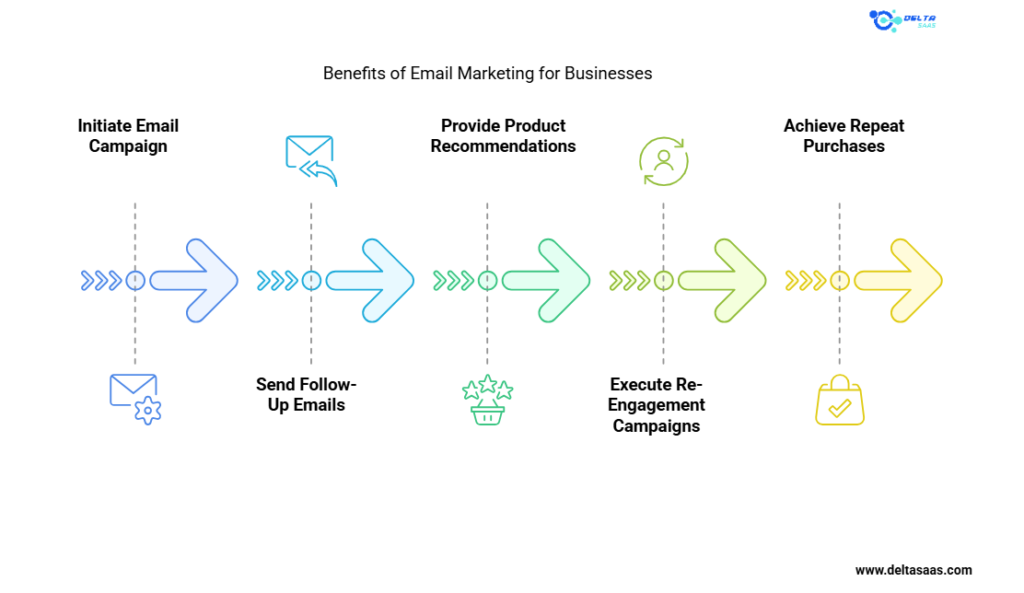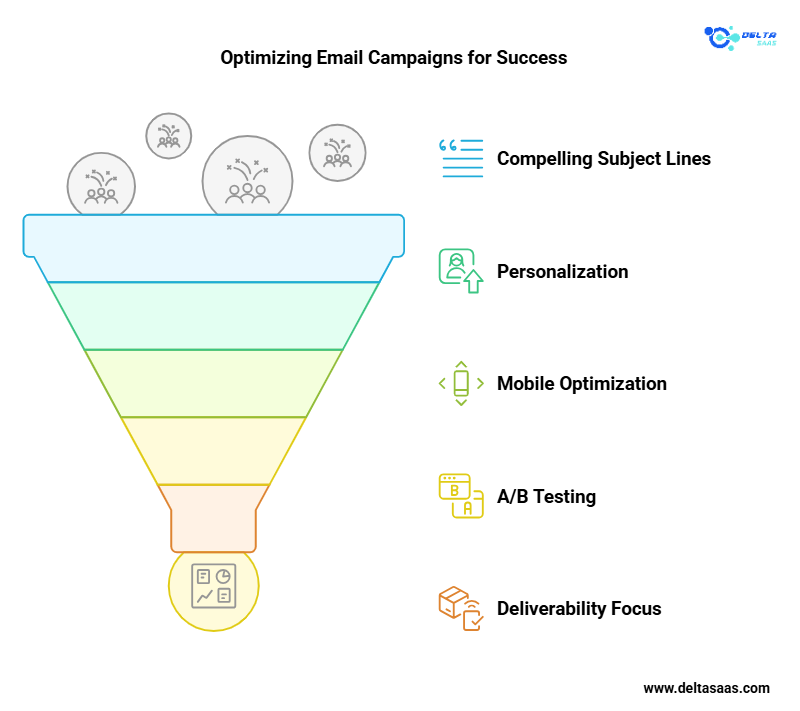Email Marketing Effectiveness: How It Drives Results for Businesses

Email marketing remains one of the most effective digital marketing strategies in 2025. It consistently delivers a high return on investment (ROI), helps businesses nurture relationships, and drives conversions. Whether you’re running an e-commerce store, a B2B service, or a small business, understanding the factors contributing to email marketing’s success can help you unlock its full potential.
This guide dives into the benefits, key metrics, and strategies that make email marketing an essential tool for any business.
Why Email Marketing Is Effective in 2025
Despite the rise of social media, video content, and other channels, email marketing outperforms many marketing strategies. Here’s why it remains so effective:
Direct and Personalized Communication
Email allows businesses to speak directly to their audience in a personal way. Unlike social media posts that target broad audiences, email campaigns can be tailored to specific customer segments using audience segmentation.
For Example, a luxury e-commerce business can send exclusive offers to high-spending customers or a lead magnet to a new subscriber interested in a specific product category. This level of personalization leads to higher engagement and conversion rates.
Read Our Top Reviews,
ActiveCampaign Features: The Ultimate Guide for Businesses
AWeber Features: Enhance Your Email Campaigns
Blastable Lifetime Deal: AI-Powered Email Marketing Solution
BrandNav Lifetime Deal: Unlock Smarter Brand Insights
Constant Contact Features: Complete Guide for Business Success
Dragit Lifetime Deal: Create Professional Emails
Dynosend Lifetime Deal: Smarter Automate Email Marketing
Email List Validation Lifetime Deal: Improve Your Marketing Results
High ROI and Cost-Effectiveness
Email marketing offers one of the highest ROIs among digital marketing strategies. According to recent email marketing statistics, businesses earn an average of $36 for every $1 spent, making it an affordable and profitable option for businesses of all sizes.
For small businesses, email marketing is particularly effective because:
- Tools like MailerLite or HubSpot provide low-cost solutions.
- Campaigns can scale as your business grows.
- It doesn’t require a significant upfront investment compared to paid ads.
Data-Driven Decisions
Email marketing is easy to measure and optimize, thanks to detailed metrics like open rates, click-through rates, bounce rates, and conversion rates. These insights allow marketers to refine their strategies and achieve better results. Businesses can use tools like Hubspot to track subscriber engagement, measure campaign performance, and adjust their marketing plans to improve outcomes.
If you’re looking for the best software, check out Delta SaaS, which offers discounts and lifetime deals on SaaS products.

Benefits of Email Marketing for Businesses
Improved Audience Engagement
Emails allow businesses to stay connected with their audience. Whether you send a weekly newsletter, a product update, or a promotional offer, regular communication keeps your brand at the top of your mind.
Enhanced Customer Retention
Using consistent and relevant email campaigns, businesses can turn first-time buyers into repeat customers. For instance, e-commerce brands can use marketing automation to send follow-up emails, product recommendations, or re-engagement campaigns to inactive customers.
Versatile Campaigns for Any Business Type
From B2B e-commerce, email marketing can be adapted for different industries. Popular campaign types include:
- Promotional Emails: Drive immediate sales with discounts or limited-time offers.
- Newsletters: Share company updates, blog content, or valuable resources.
- Transactional Emails: Confirm purchases or send shipping updates.
- Educational Emails: Share how-to guides or tutorials to build trust with your audience.
Pro Tip: Use a combination of campaign types to keep your content fresh and relevant.
Scalability and Automation
Email campaigns are highly scalable. A small startup can start with a simple newsletter, while larger businesses can leverage advanced automation workflows. For Example:
- A B2B company might set up a drip campaign for nurturing leads.
- An affiliate marketer could automate emails to promote relevant products.
Tools like Omnisend or ActiveCampaign help businesses create automated workflows, saving time and improving efficiency.
Cross-Channel Integration
Email marketing works seamlessly with other marketing channels. For instance:
- Combine email campaigns with Sprout Social to drive traffic from social media to your website.
- Use YouTube videos in emails to engage visually.
- Link email subscribers to blog content for additional value.
This integration boosts overall marketing effectiveness and ensures consistent messaging across platforms.
Read More: Email Marketing for Beginners: A Step-by-Step Guide
Key Metrics to Measure Email Marketing Effectiveness
Success in email marketing isn’t just about sending emails—it’s about achieving results. These key metrics help measure effectiveness:
Open Rate
The percentage of recipients who open your email. A higher open rate indicates that your subject lines are appealing and your emails reach the right audience.
- Industry Benchmark: 20-30% (varies by industry).
Click-Through Rate (CTR)
CTR is the percentage of recipients who click on a link in your email. It reflects the engagement of your content and calls to action (CTAs).
- Industry Benchmark: 2-5%.
Bounce Rate
The percentage of emails that couldn’t be delivered. High bounce rates usually indicate issues with your email list.
- Best Practice: Use tools like Email List Validation to clean your list regularly.
Conversion Rate
The percentage of recipients who take the desired action, such as purchasing or signing up for a webinar.
- Pro Tip: Use clear CTAs and track conversions using analytics tools like HubSpot.
ROI (Return on Investment)
Measure how much revenue your campaigns generate compared to the costs involved. Email marketing’s high ROI makes it a preferred choice for many businesses.
Click-to-Open Rate (CTOR)
This metric compares the number of clicks to the number of opens, providing deeper insights into the quality of your email content.

Best Practices for Effective Email Campaigns
- Segment Your Audience
For better results, tailor your emails to specific audience segments. For example, you can group subscribers based on age, location, or purchase history. - Write Compelling Subject Lines
Your subject line determines whether a recipient opens your email. Make it clear, concise, and intriguing. - Include Personalization
Use the recipient’s name or tailor the content to their preferences. Personalized emails have been shown to boost open rates by up to 26%. - Optimize for Mobile
Responsive templates are essential; over 60% of emails are opened on mobile devices. - Test and Refine Your Campaigns
A/B testing helps identify which subject lines, designs, or CTAs perform best. - Focus on Deliverability
To ensure emails reach your inbox rather than spam folders, maintain a clean email list and use verified domains. - Track Performance Metrics
Regularly analyze metrics like open rates and conversions to adjust your marketing strategy.
Read More: Scalable Email Marketing Services for Business Growth
Advanced Strategies to Enhance Email Marketing Effectiveness
Adopting advanced tactics can maximize your results as your email marketing skills evolve. Beyond the basics, these strategies focus on optimizing every aspect of your campaigns, from automation to personalization, to keep your audience engaged and boost your ROI.
Leveraging Marketing Automation for Efficiency
Marketing automation streamlines email processes, ensuring consistent communication while saving time. It enables businesses to send targeted, timely messages to the right audience segments.
Popular Email Automation Workflows:
- Welcome Series: A sequence of emails introducing your brand to new subscribers.
- Example: “Welcome to [Your Brand]! Here’s a special discount to get started.”
- Abandoned Cart Emails: Recover lost e-commerce sales by reminding customers about items left in their cart.
- Pro Tip: Offer a small incentive, like free shipping or 10% off, to encourage checkout.
- Re-Engagement Campaigns: Target inactive subscribers with exclusive offers or fresh content to reignite interest.
- Example: “We miss you! Come back and enjoy 20% off your next purchase.”
- Post-Purchase Follow-Ups: Build loyalty by thanking customers and suggesting complementary products.
Tools like ActiveCampaign, Omnisend, and HubSpot make setting up these workflows intuitive, even for beginners.
Personalization Beyond First Names
Personalization goes beyond adding a recipient’s name in the subject line. Using customer data, you can tailor content, product recommendations, and email timing to match individual preferences.
Advanced Personalization Tactics:
- Dynamic Content: Send subscribers different email content based on their demographics or behavior. For example, a clothing store might sell men’s apparel to male subscribers and women’s fashion to female subscribers.
- Behavioral Triggers: Send emails based on specific actions, like visiting a product page or downloading a lead magnet.
- Time-Zone Optimization: Schedule emails to land in inboxes when recipients are most likely to check their emails.
Personalized campaigns can drive higher open and click-through rates, increasing conversion rates.

Crafting Highly Effective Email Templates
Your email design impacts readability, engagement, and conversion. Clean, well-structured templates ensure your message is easy to consume.
Elements of a High-Performing Email Template:
- Attention-Grabbing Header: Use bold text or an image to hook the reader immediately.
- Compelling Body Content: Keep the text concise and to the point. Use bullet points to highlight key benefits or features.
- Strong CTA (Call-to-Action): Use clear, actionable text on buttons like “Shop Now” or “Download the Guide.”
- Branding: Incorporate your logo, brand colors, and consistent fonts.
- Footer with Essentials: To comply with legal standards, include your contact information, social media links, and an unsubscribe button.
Platforms like MailerLite and Constant Contact offer drag-and-drop email builders, making it simple to create professional designs.
Read More: Personalized Email Strategies for Higher Engagement
Improving Email Deliverability
Your email’s effectiveness depends on its ability to land in the inbox. Poor deliverability affects open rates and overall campaign success.
Best Practices to Ensure High Deliverability:
- Verify Your Email List: Use tools like Reoon Email Verifier to remove invalid or inactive addresses.
- Authenticate Your Domain: Set up SPF, DKIM, and DMARC records to signal to email providers that your messages are legitimate.
- Avoid Spam Triggers: Avoid using all caps, excessive punctuation (!!!), or spammy phrases like “Get Rich Quick.”
- Send Emails Consistently: Sudden spikes in sending volume can raise red flags with email service providers.
Pro Tip: Monitor your sender reputation using tools like Google Postmaster Tools to ensure optimal deliverability.
Tactics to Boost Engagement Rates
The ultimate goal of email marketing is to engage your audience. Here’s how you can encourage subscribers to open, click, and act on your emails:
Write Irresistible Subject Lines
Subject lines are the first thing recipients see. Aim for clarity and curiosity.
- Example: “Your Exclusive 20% Off Ends Tonight!”
- Avoid Overly generic lines like “Weekly Newsletter.”
Add Interactive Elements
Interactive content makes your emails more engaging and memorable. Examples include:
- Quizzes or polls are embedded in the email.
- GIFs or videos showcasing a product or service.
- Countdown timers for limited-time offers.
Use Social Proof
Adding reviews, testimonials, or user-generated content (UGC) builds trust. Highlight how others benefited from your products or services.
- Example: “Join 10,000+ happy customers who love our [Product Name].”
Incorporate Visual Content
While text is crucial, visuals like infographics, product images, or branded banners grab attention quickly.
Leverage Scarcity and Urgency
Phrases like “Only 3 Days Left” or “Limited Stock Available ” create a sense of urgency, which works particularly well in promotional campaigns.
Read More: Email Marketing for SMBs: Easy Strategies
The Role of Metrics in Campaign Optimization
Analyzing key performance metrics ensures you know what’s working and needs improvement. Let’s break down the most critical metrics:
Open Rates
Open rates reveal how appealing your subject lines are and whether your emails are reaching the right audience.
- Low Open Rates? Improve subject lines or clean your email list.
Click-Through Rates (CTR)
CTR indicates how many recipients clicked on your email’s content. A low CTR suggests your email body or CTA isn’t compelling enough.
- Solution: Test different CTAs or improve the placement of clickable elements.
Conversion Rates
This metric shows the percentage of recipients who completed your desired action (e.g., purchase, sign-up).
- Boost Conversion Rates by aligning email content with the landing page and simplifying the purchase process.
Bounce Rates
A high bounce rate means many of your emails failed to deliver.
- Hard bounces occur when email addresses are invalid.
- Soft bounces happen due to temporary issues, like full inboxes.
- Action Step: Remove hard bounces and monitor your email list health regularly.
Subscriber Growth Rate
Track the growth of your email list. Use lead magnets, gated content, or social media promotions to attract new subscribers.
Unsubscribe Rates
While unsubscribes are inevitable, a high rate could signal irrelevant or overly frequent emails.
- Solution: Provide an option for subscribers to update their preferences instead of unsubscribing entirely.
Measuring Email Marketing ROI
ROI is one of the most critical metrics to determine email marketing effectiveness. It’s calculated as:
ROI = (Revenue Generated – Campaign Costs) ÷ Campaign Costs × 100
For example, if you spend $500 on a campaign and earn $5,000 in revenue, your ROI is 900%.
Tips to Improve ROI:
- Use automation to nurture leads efficiently.
- Segment your audience to send more relevant content.
- Regularly optimize campaigns based on performance metrics.
Marketing Trends Shaping Email Effectiveness in 2025
As marketing trends evolve, staying updated ensures your campaigns remain effective:
- AI-Driven Campaign Optimization
AI tools can predict customer preferences, optimize send times, and generate personalized content. Platforms like HubSpot and ActiveCampaign already incorporate AI features. - Interactive Emails
Adding interactive elements like accordions, sliders, or embedded videos boosts engagement. - Hyper-Personalization
Future email campaigns will focus on real-time data to deliver hyper-relevant content, such as product recommendations or location-based offers. - Sustainability Messaging
Customers value brands that prioritize eco-friendly practices. Incorporate sustainability updates in your emails to build trust and loyalty.
Read More: Email Marketing for Lead Generation: A Complete Guide
How Email Marketing Drives Revenue Across Industries
Email marketing’s effectiveness lies in its versatility. It can generate revenue for nearly any industry, whether B2B services, e-commerce, or luxury brands. Understanding how email marketing fits into different business models helps you leverage its full potential.
Email Marketing in Ecommerce
How E-commerce Businesses Benefit:
- Driving Immediate Purchases: Promotional emails with discounts or limited-time offers encourage customers to act quickly.
- Upselling and Cross-Selling: Suggesting complementary products or upgrades through personalized emails increases average order value.
- Cart Recovery Campaigns: Abandoned cart emails recover lost revenue, with conversion rates averaging 10–15%.
Example Campaign:
- Subject Line: “Don’t Leave Your Favorites Behind – 15% Off Just for You!”
- Body: Showcase images of abandoned items with a CTA like “Complete Your Purchase.”
E-commerce brands like Amazon have perfected these tactics, making email marketing a cornerstone.
Email Marketing for B2B Businesses
Email is a powerful tool for lead generation and nurturing for B2B companies. Because the sales cycle is often longer for these companies, email helps keep potential customers engaged.
How B2B Businesses Benefit:
- Lead Nurturing: Use drip campaigns to educate leads about your services over time.
- Educational Content: Share case studies, whitepapers, or blog posts to build trust and authority.
- Relationship Building: Regularly follow up with prospects to maintain top-of-mind awareness.
Example Campaign:
- Subject Line: “How [Your Service] Can Solve [Pain Point] – A Case Study”
- Body: Include a link to a whitepaper, webinar, or blog relevant to the recipient’s industry.
B2B companies often rely on platforms like HubSpot for advanced segmentation and automation.
Read More: Choosing Effective Newsletter Services for Your Business
Email Marketing for Luxury Brands
Luxury brands benefit from email’s ability to deliver personalized, exclusive experiences to high-value customers.
How Luxury Brands Benefit:
- Exclusive Offers: Limited-time invitations to VIP events or product launches create urgency.
- High-Quality Visuals: Luxury brands use visually stunning emails to reflect their premium image.
- Customer Loyalty: Personalized birthday greetings or anniversary offers deepen customer relationships.
Example Campaign:
- Subject Line: “Your Exclusive Invitation to Our New Collection Preview”
- Body: Use high-resolution images, minimal text, and a direct link to RSVP or shop.
Overcoming Common Challenges in Email Marketing
While email marketing is effective, there are challenges to address. Here’s how to solve them:
Low Open Rates
- Problem: Subscribers need to pay attention to your emails.
- Solution: Optimize subject lines, segment your list for relevance, and personalize emails.
High Unsubscribe Rates
- Problem: Subscribers opt out, reducing your list size.
- Solution: Avoid over-emailing, provide value in every email, and let users adjust their preferences.
Poor Conversion Rates
- Problem: Subscribers open your email but don’t take action.
- Solution: Test different CTAs, simplify landing pages, and offer irresistible incentives.
Spam Complaints
- Problem: Emails flagged as spam damage your sender’s reputation.
- Solution: Use a clean email list, avoid spammy language, and always provide an easy opt-out option.
Key Tools for Campaign Optimization
To ensure your campaigns are both practical and efficient, here are the tools every marketer should consider:
| Tool | Purpose | Why It’s Important |
| HubSpot | Automation, CRM, Analytics | Comprehensive for advanced email marketing. |
| ActiveCampaign | Segmentation, Automation, Testing | Great for personalizing and testing workflows. |
| Omnisend | Multichannel Integration | Ideal for e-commerce businesses. |
| Reoon Email Verifier | List Cleaning | Improves email deliverability. |
| MailerLite | Beginner-Friendly Design Templates | Easy to use for creating professional emails. |
| Sprout Social | Social Media and Email Integration | Perfect for cross-channel promotions. |
These tools provide the features needed to optimize campaigns at every stage, from list building to measuring performance.
Trends in Email Marketing Metrics
As businesses continue to invest in email marketing, understanding key trends ensures campaigns remain effective.
Rising Open Rates with Personalization
Emails with personalized subject lines see 26% higher open rates. This trend underscores the importance of audience segmentation and relevant content.
Mobile Optimization Is Critical
Over 60% of emails are now opened on mobile devices. Brands need to optimize for mobile to avoid losing subscribers.
Interactive Content Drives Engagement
Adding interactive elements like polls, GIFs, or embedded videos boosts engagement rates by 73%.
Data Privacy Awareness
With stricter data regulations (such as GDPR and CCPA), businesses must prioritize compliance and transparency in their email marketing practices.
Read More: Automated Email Marketing: Boost Campaign Success
Conclusion
Email marketing effectiveness is proven by its ability to drive revenue, boost engagement, and deliver a consistently high ROI. Its versatility, cost-efficiency, and measurable impact make it essential for businesses in every industry, from e-commerce to B2B.
Businesses can maximize the success of their campaigns by leveraging advanced tools, optimizing for key metrics, and staying updated with marketing trends. Whether new to email marketing or looking to refine your strategy, the insights shared here provide a roadmap for building and executing impactful campaigns.
Email remains the backbone of digital marketing in 2025—don’t miss out on its potential to grow your business.
FAQs About Email Marketing Effectiveness
What is email marketing effectiveness?
It measures how well email campaigns achieve engagement, conversions, or revenue growth goals.
Why is email marketing still effective?
It’s direct, cost-effective, highly measurable, and delivers a high ROI across industries.
What is the ROI of email marketing?
On average, businesses earn $36 for every $1 spent on email marketing.
How do you measure email marketing effectiveness?
Track metrics like open rates, click-through rates, conversion rates, and ROI.
What are the best tools for email marketing?
Tools like HubSpot, MailerLite, Omnisend, and ActiveCampaign offer robust features.
What are the disadvantages of email marketing?
Challenges include spam complaints, low open rates, and list maintenance.
Is email marketing effective for small businesses?
It’s cost-effective and ideal for reaching specific audiences with minimal resources.
What is the success rate of email marketing?
Success depends on industry and goals but often exceeds other channels in ROI and engagement.
How can I improve email conversion rates?
Use strong CTAs, personalized content, and optimized landing pages to increase conversions.
Is email marketing still relevant in 2025?
Absolutely! Email marketing continues to evolve with trends like automation, AI, and interactive content.


